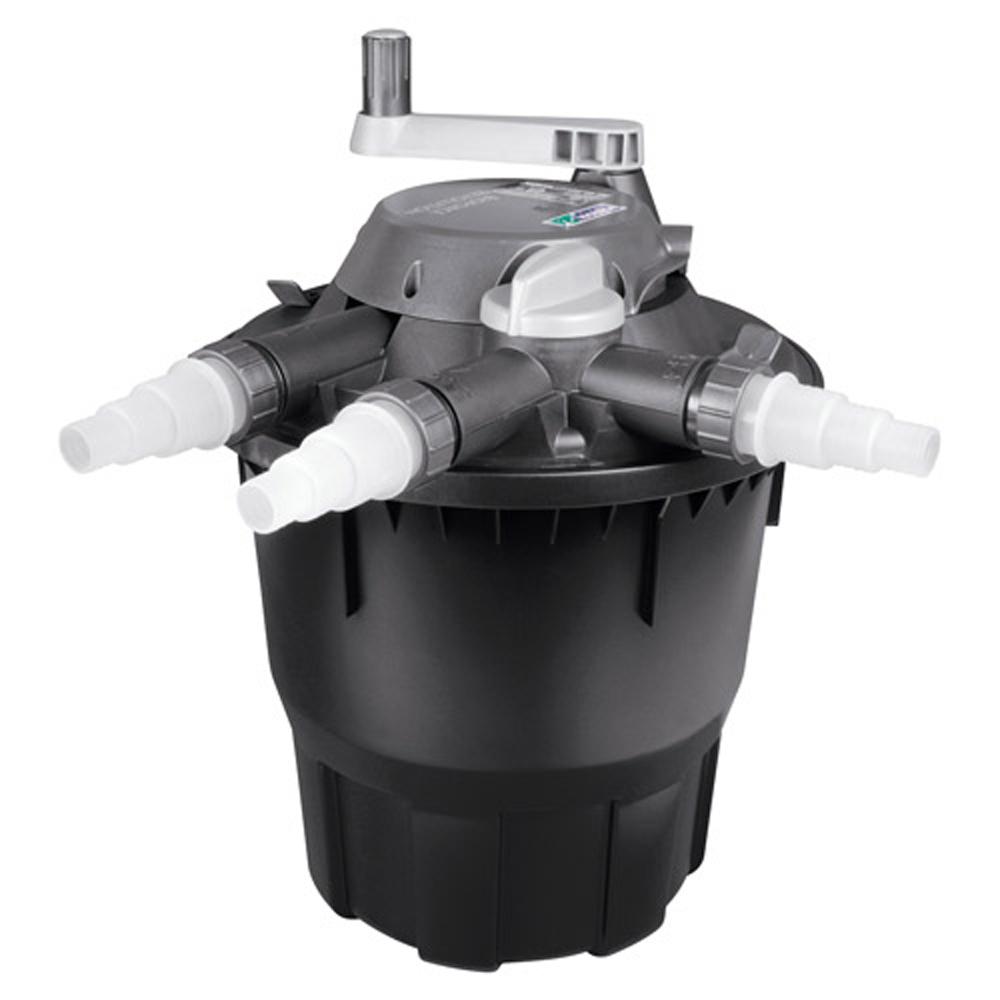How to clean pond water
While a pond can be a beautiful feature of any property, taking care of a pond is no easy feat. No matter the size, keeping your pond clear, healthy and clean can be a daunting task, especially if you’re not sure where to begin. From choosing the right filter, to learning what plants can help keep the water healthy, there are many aspects of learning how to clean pond water. Read on to find out how to clear pond water and create a naturally thriving ecosystem, as well as discover the best ways to clean pond water with the help of us here at Aquacadabra.
The first question you may be asking is ‘how often should you clean your pond water?’. And the answer is that it can vary, and is particularly dependent on the size and location. Smaller ponds may require more frequent cleaning, as will ponds kept in areas that see excess debris falling onto the surface, as this will need to be cleared often to ensure your aquatic life remains healthy. However, the general consensus is that pond water should be cleaned on average once or twice per year.
The key to keeping your pond water clean and the pond life healthy is to check on it regularly. In most cases, you will be able to tell from the colour of the water whether your pond is in good condition or not. However, if you’re wanting more information on the quality of your pond water there are water test kits available that can help you determine the quality, pH and purity of your pond water.
How do I make my pond water clear naturally?
After putting a lot of time, energy and money into creating the perfect pond, the last thing you want is to see murky water. However, there are many ways you can help your pond to maintain clear water naturally without the use of any harsh chemicals that may affect the ecosystems thriving in the pond.
One of the easiest ways to ensure your pond water is kept clear is to add beneficial bacteria to it. This beneficial bacteria works by breaking down nutrients in the pond and starving out any algae that may be overgrown. Each beneficial bacteria method works differently, you can choose a specialised product such as the Cloverleaf Absolute Pearls (£13.60) or Evolution Aqua Pure Pond Balls (£12.45) detailed below, or for a more simple option, adding a layer of rocks to the bottom of your pond can also help to promote the growth of beneficial bacteria.


These Cloverleaf Absolute Pearls are a natural product designed to help maintain a healthy pond environment. The pearls contain a combination of microscopic nitrifying bacteria and bio-active enzymes that help to break down any harmful levels of ammonia and nitrite found within ponds. These fast-acting enzymes get rid of any dead algae, sludge and uneaten food left in the water to prevent it from building up in your pond and filter system, causing murky water. Suitable for all ponds including koi and fish ponds, Cloverleaf Absolute Pearls will help you achieve that crystal clear pond water you want without risking the safety of your aquatic life.
Similar to this, the Evolution Aqua Pure Pond Balls are crammed full of live bacteria in a biodegradable ball that, once placed into the pond, slowly releases good bacteria when needed the most. With over 8 billion bacteria per litre, these Evolution Pond Balls are guaranteed to keep your pond looking crystal clear. Add these balls either directly into your pond or into your filter, once per month to help break down organic waste and balance the ammonia/nitrate cycle for a beautiful, healthy pond.
Another way to ensure your pond water is kept clear naturally is to use the right aquatic plants. The use of plants in ponds is highly beneficial to the natural ecosystems of the pond as they help to remove excess nutrients from the water and prevent unwanted contaminants from entering the water, as well as reducing the light levels of the pond to hinder the overgrowth of unwanted algae. There are a wide variety of beautiful aquatic plants that you add to your pond, depending on the size, location and temperature of your pond. While you’re deciding what plants are best for you, browse through our full collection of pond planting supplies, or read our full Guide to Aquarium Plants to help you along the way.
Finally, an easy way to help keep your pond water clear naturally is to simply not add too many fish. Although fascinating to look at, having too many fish in one pond results in too much fish waste and in turn causes unclean, murky water. How many fish you should have in your pond is not only dependent on the size of your pond but also how well your pond’s ecosystem can handle the amount of waste - if you have a larger biofilter then your pond should be able to handle a higher amount of waste.
Some of the most common signs of fish overpopulation in your pond are:
- Excessive string algae - if your pond has a good filtration system and lots of aquatic plants but is still suffering from the effects of string algae, this may be a sign that you have too many fish in your pond.
- Difficulty in keeping the pond water clear despite good filtration, regular cleaning and beneficial bacteria.
- Fish illness or death - if you notice your fish starting to gasp at the surface of the water, develop white spots or not eating their food, this is a sign that they are ill and also a sign your pond is overcrowded.
By removing fish from your pond or investing in a larger filtration system, you can help to keep your pond cleaner and free from unwanted bacteria.
How do you clean a pond without draining it?
Cleaning a pond without draining is the least disruptive method when it comes to maintaining a healthy pond, as it allows the majority of the good bacteria to continue providing biological filtration during and after the worst of the waste is removed. In order to clean a pond properly, fully draining all of the water out of it should be considered only as a last resort. There is a common misconception that to effectively clean a pond you must first remove the old water, however this is not necessary. Pond water that has been there for a long time, although you may think is “bad quality” water, actually contains a lot of good bacteria and microorganisms which are vital to keeping the natural ecosystem of the pond balanced.
One of the easiest ways to ensure a clean pond without draining the water is by using a product such as, Aquacadabra Vanquish Sludge (£7.99) or Bermuda Sludge Bomb (£10.95). These products are highly effective at removing unwanted sludge and waste from your pond to help keep it clear and healthy. The Vanquish Sludge from Aquacadabra contains a concentrated amount of beneficial organisms which work to dispose of fish waste, decrease sedimentation, improve the performance of biological filters and consume any dangerous levels of nitrate or ammonia, all without you having to drain your pond.


The Sludge Bomb from Bermuda also helps to digest sludge both in your pond and surrounding water features. Safe for any fish or wildlife living in your pond, this Sludge Bomb is a single use product that effectively eradicates the presence of toxins, reducing sludge and helping to minimise organic waste build up, for a clean and clear pond without the hassle of draining.
By fully removing the entirety of old pond water, you put your pond at risk of removing beneficial bacteria. Helpful bacteria that live in mature pond water play a large role in breaking down harmful fish waste and help to make the water safe for aquatic life. Therefore, we highly encourage you to retain as much of the mature pond water as possible during cleaning. Below we will outline a few of the key steps to maintaining the good bacteria and natural biological filtration of your pond water without draining it, whilst also effectively cleaning it.
Clean your pond in Spring or Autumn. Spring is when the water temperature starts to rise and your fish become more active in the pond, therefore choosing to give your pond a nice spring clean at this time will give your fish a nice fresh start for the new season. During mid-late autumn is also a great time to give your pond a more intensive deep clean. This is around the time most of the leaves have fallen off the trees which can then be netted away, and the young amphibians that were born earlier in the year are now adults that can safely vacate the pond during cleaning.
Remove all debris. One of the most important steps to cleaning pond water is to remove any floating debris, using a pond net or, if the pond is in an area where debris may fall in frequently, using a pond vacuum. A good quality pond vac is a long-term investment and a helpful tool when collecting debris on an ongoing basis to catch any debris you may miss and help to prevent the build-up of sludge on the bottom of the pond. Here at Aquacadabra, we have a wide range of pond vacuums and pond nets that can help streamline your pond water cleaning process.
Dechlorinate tap water. If you choose to partially drain your pond for cleaning, it’s important to note that filling it up with tap water without first using a dechlorinator can cause disturbance to the natural ecosystem of the pond. Chlorine is naturally found in tap water, making it safe for humans to drink but toxic to aquatic life. Therefore we recommend dechlorinating your tap water before using it to top up your pond or, alternatively, collect rainwater in a water butt and use that instead. There are a variety of quality dechlorinators available to purchase here at Aquacadabra.
Use a pond filter. Pond filters work by clearing out unwanted toxins and introducing oxygen into the water in order to keep it clean, clear and free from algae. There are two main elements to an effective pond filter - a mechanical filter and a biological filter, a combination of both is the most effective way to keep your pond water clean without draining it. A mechanical filter removes any physical contaminants that you may have missed with a pond net and a biological filter helps break down any harmful waste and decreases any toxic levels of nitrate or ammonia that can be found in the water. There are three main types of pond filters that can be used - gravity, UV and pressure filtration.
- Gravity pond filters use a pump inside of the pond to feed water to the filter, the water is then passed through the filtration system and returned to the pond using the force of gravity. One of the best gravity filtration systems available at Aquacadabra is the Fish Mate GBIO Gravity Filter 5000L (£34.95).

The Fish Mate Bio Filter is a 3-stage mechanical and biological gravity filtration system used as an effective way to give you better water clarity and a healthy pond environment. Easy to use and designed to be integrated into a wide range of pond filters such as UV filters for increased effectiveness, this gravity filter is a great choice for quick and simple pond maintenance.
- UV pond filters work in two separate parts - the filter and the UV light. The UV light within the filter helps to clarify and sterilise pond water. The pond water passes through the UV light and removes algae and any harmful bacteria, whilst the filter part uses mechanical or biological filtration to get rid of any unwanted debris or harmful waste. Once the pond water has passed through the filter, the clean, healthy water gets pumped back into the pond. One UV pond filter we recommend is the Hozelock EasyClear 3000 (£124.99).

The EasyClear 3000 is a fully integrated in-pond filter that promotes clear and healthy pond water. This efficient, integrated pump is easy to install, requires no tools and is suitable for ponds up to 3000 litres. Featuring foam filters to ensure crystal clear water and Kaldnes biomedia to keep your pond plants and fish healthy, with 5 watts of UVC to help eliminate green water. This UV pond filter also doubles as a fun water feature, with the choice of either a fountain or waterfall.
- Pressurised pond filters are one of the most popular choices to keep your pond clean. These filters are closed and can be placed outside of the pond in a convenient location. Due to its closed nature, this filter helps to maintain the pressure of the pump and allows the clean water to flow freely through pipes once filtered. Additionally, due to the pressure of these filters, the clean water can be carried upwards if needs be which can be useful for any water features you may have. One of the best-selling pressure pond filters available here at Aquacadabra is the Hozelock Bioforce Revolution 6000 (£329.99).

The Hozelock Bioforce Revolution 6000 is an easy clean, 3-step filter system that helps to maintain clear and healthy pond water. Suitable for ponds up to 6000 litres, this pond filter includes a high-power 18w UV clarifier, with both biological and mechanical filtration to eliminate green water and maintain beneficial bacteria. Using pressurised filtration to prevent clogging and flow loss, the unique Cypricube foam filters effectively remove waste and promote clear, clean water.
How do you clear murky pond water?
Disruption to your pond’s natural ecosystem can tint your beautiful pond water an unsightly green or brown colour. However, there’s no need to worry as there are many ways in which you can clear murky pond water naturally and with the help of a few handy tools.
Whether you wish to rid your pond of murky water naturally, manually or with the help of some effective pond filters and vacs, below we will outline some simple steps you can take to keep your pond water crystal clear.
- Check your pond filter. As mentioned previously, there are many different types of pond filters available but whichever one you choose, you must remember to clean it regularly and check that it is still in good condition. Ideally, you should clear out your pond filter three times per year, check to see if there is any debris blocking the filter and clean out any sludge it may have acquired. A dirty or faulty pond filter will reduce the effectiveness and may result in a murky pond.
- Remove any floating debris. Just as you would when cleaning your pond, regularly removing any debris floating in your pond will help to reduce the chances of the water becoming contaminated and murky.
- Thin out any pond plants. Although beneficial to the health of your pond and any fish or creatures living in it, there is such a thing as too many pond plants. Routinely thinning out, trimming and removing pond plants not only helps with overgrowth and provides the right conditions for pond life but also helps to keep the water clear.
- Adding a pond supplement. A high-quality pond supplement that contains bacteria and biological boosters, such as an algae or green water treatment, can help to restore the natural bacteria in the pond and create crystal clear, healthy water.
- Don’t overfeed your fish. It’s important not only for your pond but also for the health of your fish that you do not give them too much food. Only feed your fish the amount of food they will be able to consume within the first few minutes of you throwing it into the pond. Any excess food that your fish do not eat will sit at the bottom of the pond and start to rot, slowly turning into unwanted sludge and causing ammonia build-up.
Keep your pond clean and clear with Aquacadabra
Keeping your pond water clean and the ecosystem within thriving is not as difficult as it may seem. Simply follow our advice and tips above to ensure your pond is kept in the best condition possible, so you can sit back, relax and enjoy the view of your crystal clear pond.
If you’re looking for further ways to keep your pond in the best condition possible, browse through our full collection of pond supplies to find out more. Alternatively, if you have any questions or need advice on maintaining your pond, get in touch with our fish experts here at Aquacadabra today.



